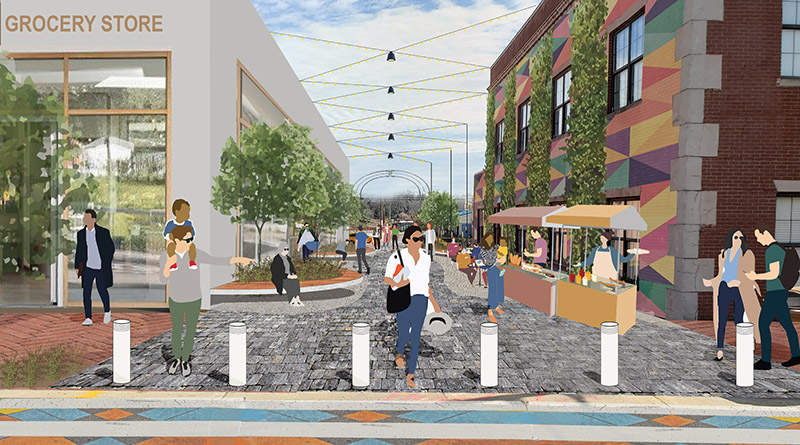The City of Hackensack and the Northern New Jersey Community Foundation (NNJCF) worked with the public and members of the arts community to develop recommendations for activating a downtown pedestrian walkway. Image Credit: Together North Jersey
In the Fall of 2019, pedestrians walking along Demarest Place in downtown Hackensack were greeted by a booth called “The Hacktivator.” They were asked to respond to the question “What brings you back to life?” and push a button. Once the button was pushed, performers in the booth sprang to life to dance, rap, or act out a skit. Months later, downtown residents, visitors, and employees once again stopped along Demarest Place to respond to questions, this time in the form of a survey and without the theatrics.
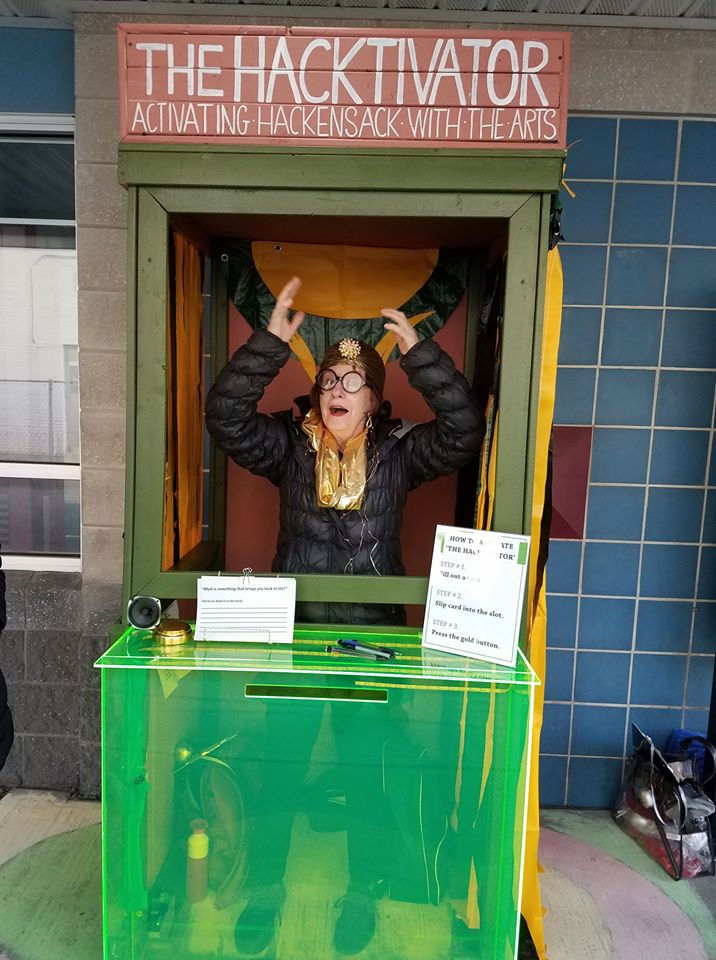
These and other outreach efforts carried out over the last year have culminated in a conceptual plan to transform an existing pedestrian walkway into a lively public space activated by the arts. The Demarest Place Community Vision Plan, issued in August, envisions the use of art installations and small performances, along with seating, lighting, and landscaping, to create an inviting gateway into the downtown area.
The plan was prepared by Together North Jersey (TNJ) in partnership with the City of Hackensack and the Northern New Jersey Community Foundation (NNJCF). TNJ is a cross-sector consortium that promotes sustainable development and is led by a partnership between Rutgers University and funder the North Jersey Transportation Planning Authority (NJTPA).
The City hopes the transformed space will provide an inclusive community space, draw visitors into the downtown, and bolster ongoing redevelopment efforts.
“At a minimum, the activation of Demarest Place will help ensure that the visitors and travelers are safe and comfortable in using the corridor,” says Albert Dib, Director of Development at the City of Hackensack. “At its fullest potential, the corridor will be a destination in, and of, itself through the incorporation of visual and performance art.”
The proposed plans for Demarest Place are one of numerous efforts to advance Transit-Oriented Development (TOD) around the NJ TRANSIT Hackensack Bus Terminal. The terminal is located to the east of the pedestrian walkway, on an NJ TRANSIT-owned segment of Demarest Place used by buses. The facility provides regional service to locations in northern New Jersey, including Newark and Jersey City, as well as George Washington Bridge Station in Upper Manhattan.
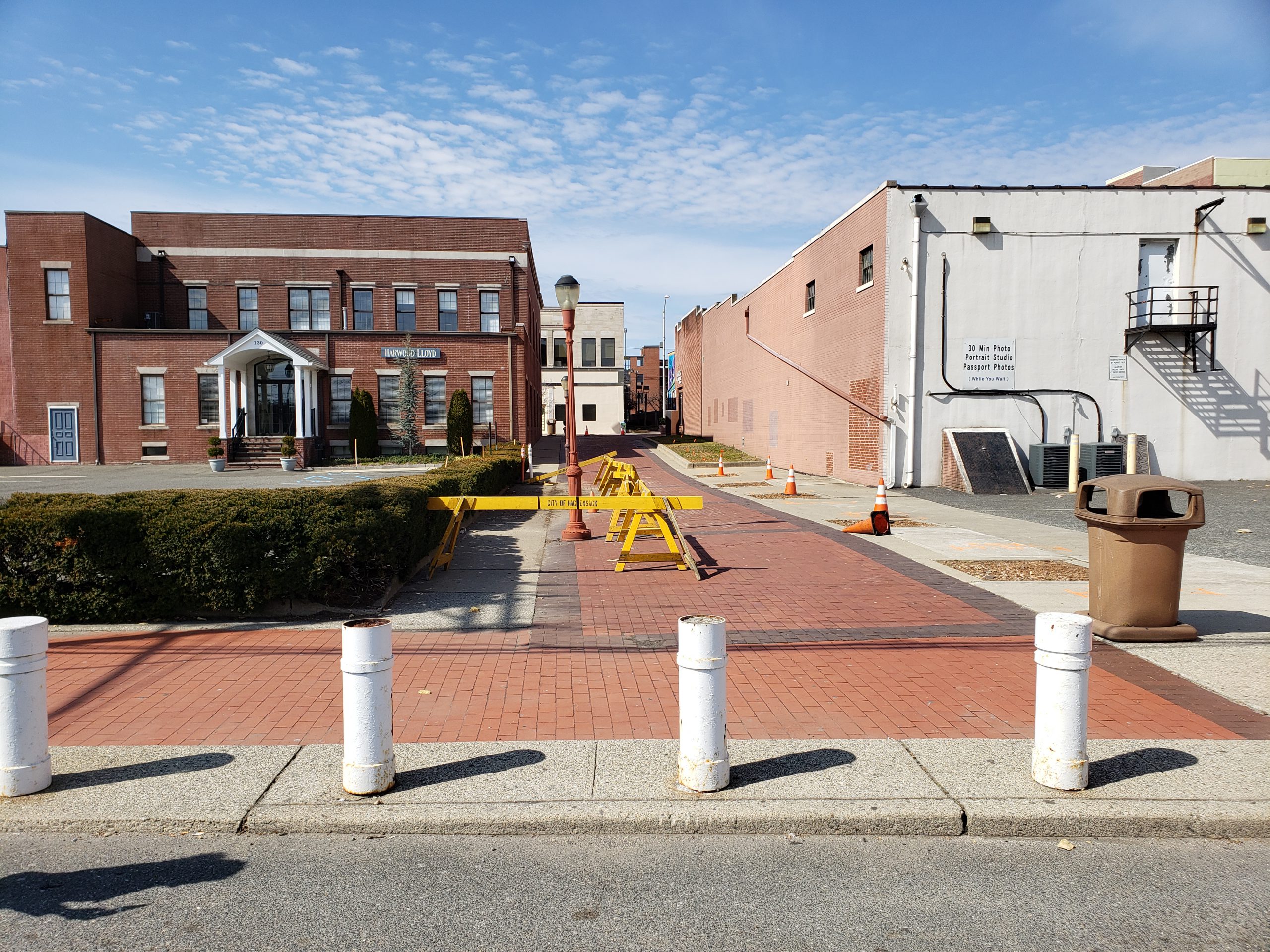
New zoning and redevelopment plans adopted by Hackensack since 2012 encourage transit-friendly development through increased density, mixed uses, wider sidewalks, and streetscape improvements, as well as public art. In 2016, the New Jersey Department of Transportation designated an area around the Hackensack Bus Terminal a Transit Village, which makes the City eligible for state grants to fund streetscape, transit station, and other improvements that support TOD.
These efforts have resulted in new multi-family developments in the downtown, as well as new cultural amenities. The Atlantic Street Park, completed in 2015, features an outdoor stage that hosts concerts and movie nights. The adjacent Hackensack Performing Arts Center (HACPAC), which opened in 2017, features musical and theatrical performances and an art gallery. The downtown is also home to Bergen Community College and various state, county and municipal buildings.
Demarest Place is located in the heart of the downtown, intersecting with Main Street between East Mercer and Atlantic Streets. Both segments of Demarest Place are currently used as a pedestrian walkway. The segment to the east of Main Street leads from the Hackensack Bus Terminal to Main Street. The western segment connects a municipal parking garage and private surface parking to Main Street.
Once activated, the walkway will provide an engaging connection between transportation facilities and the major employers and shopping, dining, and cultural amenities in the area.
The City plans to excavate the eastern portion of Demarest Place to install stormwater infrastructure. The excavation presents an opportunity to work with developers in the area to rebuild the walkway.
Despite the existing cultural amenities and shopping and dining options, the downtown currently is a “9-to-5” area, with employees leaving in the late afternoon and HACPAC patrons often leaving the area directly after performances. Dib hopes an activated Demarest Place will augment new outdoor dining along Main Street and encourage nightlife.
Demarest Place has been the focus of creative placemaking efforts for several years. The TNJ assistance builds on previous work completed by the City and local partners to conduct public engagement and beautify and enhance the area. The Main Street Business Alliance led efforts that resulted in artistically-painted utility boxes along Main Street and a large “Greetings from The Sack, New Jersey” mural in the western segment of Demarest Place.
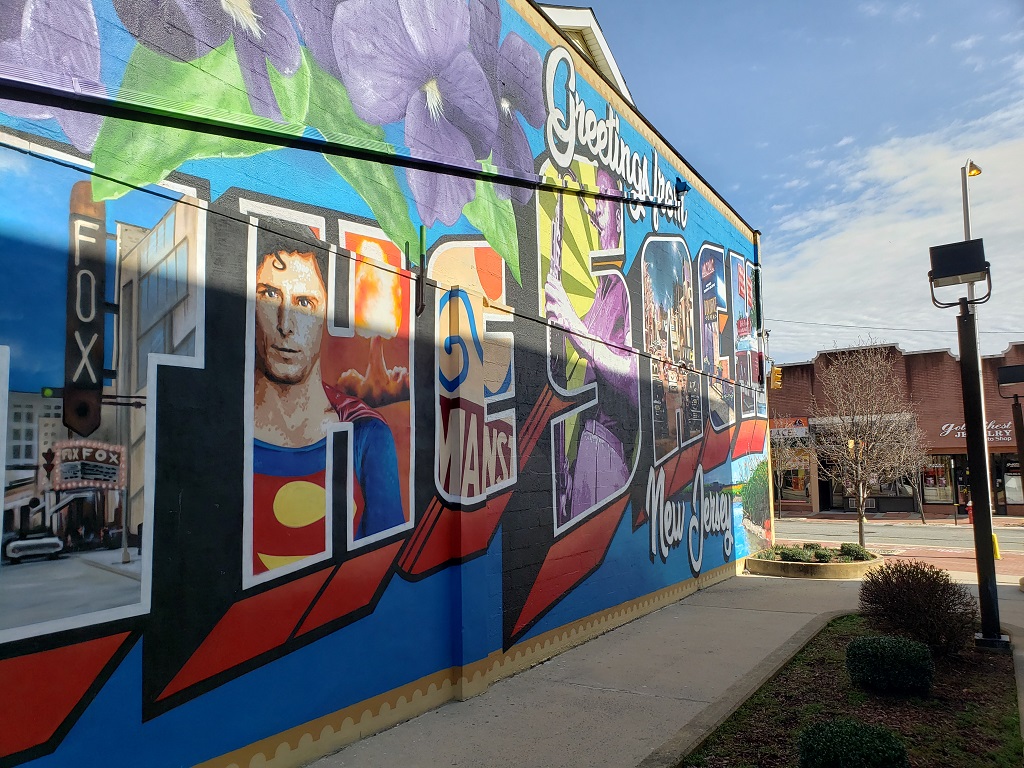
In December 2019, before the COVID-19 pandemic struck, TNJ awarded the City of Hackensack and NNJCF assistance to develop a community-based vision for Demarest Place. The assistance comes at a time when communities are searching for ways to provide safe, local, outdoor spaces amid social distancing orders.
“Even before the pandemic, Hackensack was looking for ways to improve walking and biking downtown. The City’s proposal to re-imagine Demarest Place was key to those efforts, which is why it was selected to receive technical assistance through Together North Jersey,” says Mary D. Ameen, Executive Director of NJTPA. “While public transportation use has dropped during the pandemic, this project will also help advance the City’s plans for transit oriented development and create more transportation opportunities for residents and those who work in or visit Hackensack’s downtown.”
From January to May of 2020, the TNJ project team administered surveys to members of the public and spoke to local business owners and representatives of the Main Street Business Alliance. In April, amid COVID-19 social-distancing measures, TNJ facilitated an online workshop with members of the Hackensack Creative Arts Team (CAT), a coalition of community members working to promote the arts and culture in the downtown. Local artists, representatives of local arts organizations, and other community members joined the Zoom call to suggest ideas ranging from Wi-Fi charging stations, to multi-lingual signage, to overhead paper airplane displays.
TNJ also held interviews with developers active in the area. A number of redevelopment projects at sites in the immediate vicinity of Demarest Place are in the proposal or planning approval stage or under construction, including a proposed mixed-use building that would line the northern edge of the eastern segment of the walkway. These projects will dramatically change the downtown, bringing higher-end housing and thousands of new residents into the area.
Hackensack is a racially and ethnically diverse community and home to a large immigrant population. Danielle De Laurentis, Associate Director of NNJCF says the TNJ visioning effort was an opportunity to consider how Demarest Place could serve both new and existing residents.
“Creating points of interest and arts engagement for new residents is a key goal,” says De Laurentis. “Of equal importance is fostering local ownership during the transition to this new Main Street, to instill a sense of belonging for the existing community.”
“Creating points of interest and arts engagement for new residents is a key goal. Of equal importance is fostering local ownership during the transition to this new Main Street, to instill a sense of belonging for the existing community.”
The plan for Demarest Place identifies four major themes distilled from public and stakeholder outreach:
- Community, Inclusivity and Diversity
- The Arts
- Shopping and Dining
- Green Space
These themes formed the basis for the recommended placemaking activities and installations, as well as conceptual designs, developed by a graduate student at the Rutgers Edward J. Bloustein School of Planning and Public Policy, to help the local community members and decision-makers envision possibilities for the space.
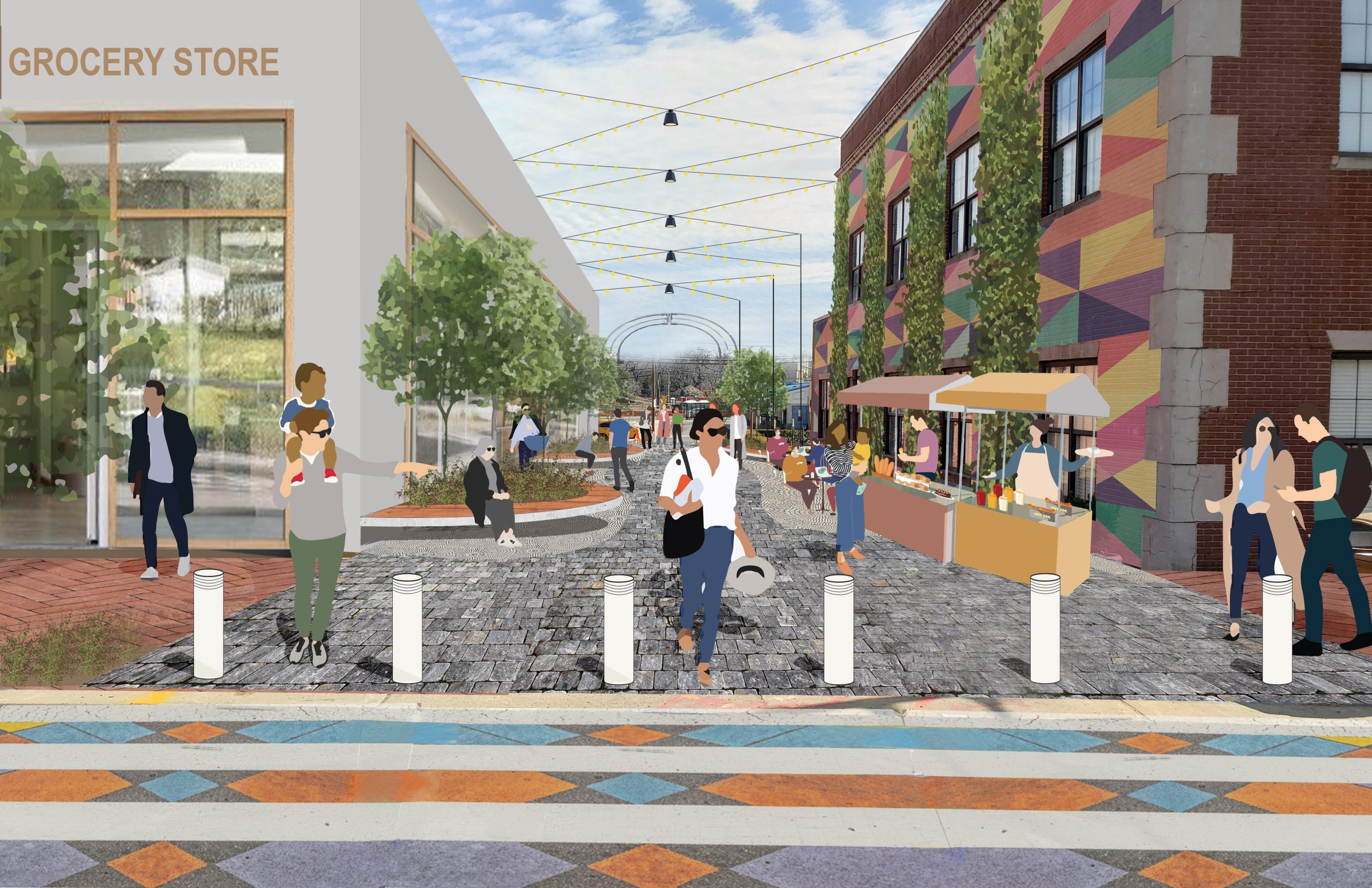
Demarest Place is too narrow to function as a typical public plaza, but the plan envisions spaces for people to sit and relax and a continuous program of varied pop-up art installations and activities that invite passers-by to linger. The plan recommends dozens of activities and installations that will allow the community to express its rich diversity, such as poetry readings, musical performances, local vendor markets, and storyboards that tell the life stories of long-time residents. Permanent design features include bench planters, overhead string and pedestrian lighting, multi-lingual wayfinding signage, and paving stones arranged in a winding shape along the center of the walkway to evoke the Hackensack River.
The next step for the City, says Dib, is to share the recommendations with area developers and residents to solidify the vision. The City will then engage design professionals to determine the proper scope, design, phasing and roll-out of the walkway’s redesign and activation, and pursue funding for implementation. In 2018, the City and NNJCF applied unsuccessfully for a National Endowment for the Arts Our Town Grant. With a community-driven vision for the walkway in place, the partners are now prepared to present a more competitive application.
Together North Jersey (TNJ) was created in 2011 to develop the first comprehensive plan for sustainable development for North Jersey. Since 2016, TNJ partners have been working together to implement the Plan through convenings, outreach, local technical assistance and trainings. The TNJ Local Assistance Program supports local initiatives that advance the focus areas and strategies of the Plan. Eligible applicants include municipal governments, county governments and non-profit, community-based or non-governmental organizations (NGOs) in the TNJ region. The program is funded by the North Jersey Transportation Planning Authority (NJTPA). Assistance is provided by the Alan M. Voorhees Transportation Center at Rutgers University (VTC).

